How do Air Conditioners Work? The purpose of your air conditioner is to remove heat from inside your home or building and reject it to the outside, in addition to removing moisture and filtering the air. We’ll learn how an Air Conditioner does this by moving heat around using a refrigerant. We’ll also show the major components that get installed and how they’re connected together.
If you prefer to watch the video of this presentation, then scroll to the bottom or click this link. How do Air Conditioners Work
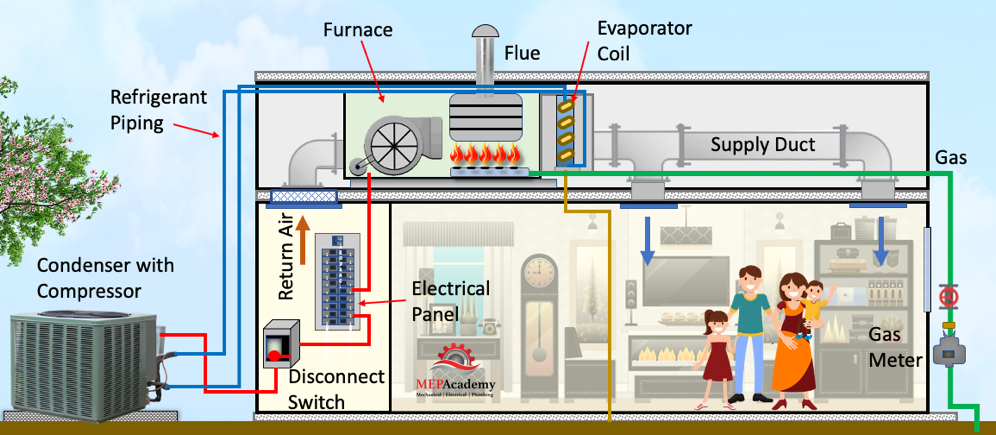
First you would install the condenser or outside section where the compressor and condenser coil are located. Next install the air handler in the attic. We show this one has a horizontal air handler with a furnace. We’ll show you a vertical unit shortly. Then the indoor and outdoor sections are connected with ACR type copper tubing. Inside the copper tubing is where the refrigerant circulates between the indoor and outdoor coils. Then we need to provide a circuit breaker that can handle 208/230 volts, single phase power, and run electrical conduit and wire from the panel to a disconnect switch and then make a connection to the outdoor unit. Then will install another circuit breaker in the electrical panel for 115 volts and fed the indoor air handler.
Checkout these Air Conditioners hereNext for gas/electric units using a furnace we’ll install gas piping from the gas meter to the indoor air handler. Next, we’ll need to run a condensate drain from the indoor air handler’s DX cooling coil to a drain or the tailpipe of a sink.
Next, we’ll connect the return air ductwork to the indoor air handler and provide a filter grill in the ceiling for easy access for filter changeouts. Next we need to install the supply ductwork from the air handler to each room that will get supply air. These are the basics of how a split system air conditioner is connected.
And, here is what it might look like if you’re using a vertical unit. There is a move to go all electric and get away from burning fossil fuels, so the use of Heat Pumps seems to be increasing. If installing a heat pump there is no need for gas piping or a furnace as the Indoor and outdoor coils change to accommodate the requirement for either heating or cooling. See our video on “How Heat Pumps Work” for a better description.
How Heat Moves
If you left a hot cup of coffee on the table, it would lose its heat to the surrounding air and eventually its temperature would be close to the indoor air that surrounds the cup. This is how heat transfer works, heat always tries to equalize itself with the cooler surroundings, so any heat in the air will be attracted to the cold surface of the coil.
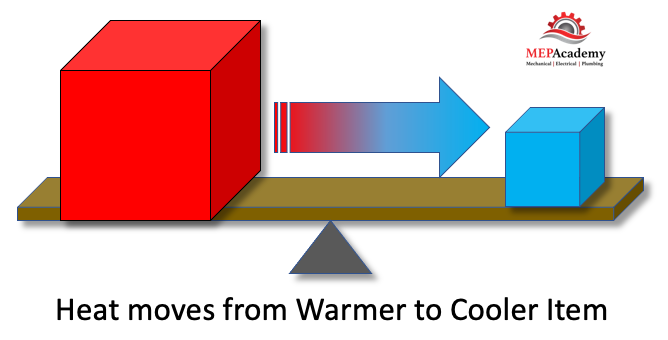
The second law of thermodynamics states that “Heat always moves from a warmer object to a cooler one, and seeks equilibrium”. One more example is if you had a glass filled with ice water sitting outside during a hot summer day, the heat from the air would transfer into the ice water causing the ice to melt and the water to reach the outdoor air temperature.
Refrigerant
A special substance called a refrigerant circulates through the piping of the air conditioner from the indoor coil to the outdoor coil. The refrigerant is designed to absorb heat from indoors and reject the heat outdoors. The refrigerant does this by changing from a liquid to a gas and then back to a liquid.
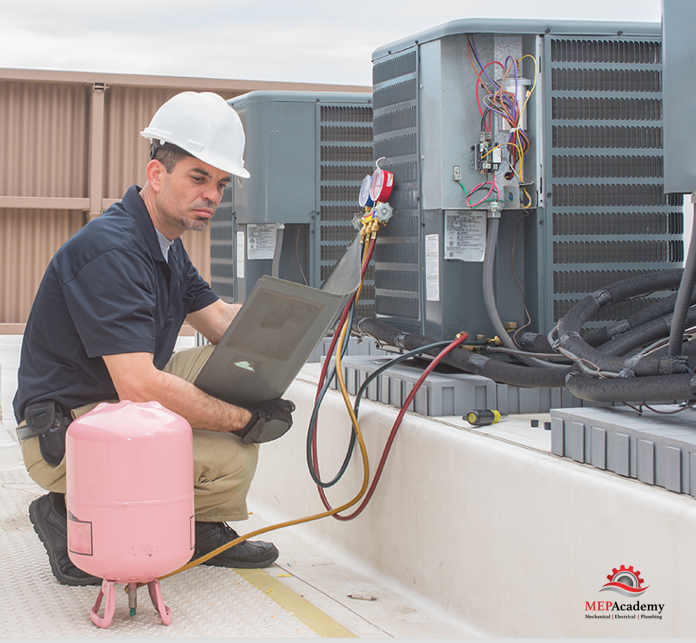
Refrigerants absorb heat when it changes from a liquid to a gas, and then gives up its heat when changing back from a gas to a liquid. The refrigerant is pumped around from the indoors to the outdoors by a compressor, while constantly changing from a gas to a liquid and then back to a gas again, repeatedly. For a better explanation of the refrigerant cycle see our video “Refrigeration Cycle 101”.
Compressor
The compressor is like a pump which uses electricity to power a motor, which causes the refrigerant to move around the piping circuit while increasing the temperature and pressure of the refrigerant before sending it to the condenser coil. There must be a difference in pressure between the high-side and the low-side for the refrigerant to move and for oil to return to the compressor. The compressor causes this difference in pressure and makes the refrigerant circulate through the system. The low-side being the indoor evaporator, and the high-side being the outdoor condenser coil. In a heat pump system these heat exchangers can be reversed and serve the opposite purpose.
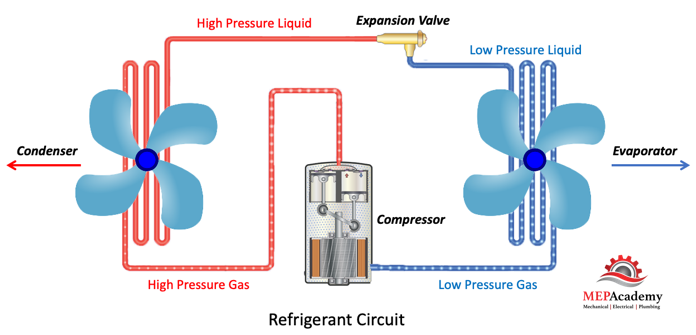
The compressor raises the temperature and pressure of the refrigerant so that the heat in the refrigerant is above the outdoor design temperature. Remember that heat transfers from the warmer item to the cooler one. So, if the outdoor temperature is 95°F (35°C), then the refrigerant in the condenser needs to be above that to transfer the heat out of the refrigerant to the warm outdoor air. As the temperature of the air outdoors approaches the temperature of the refrigerant in the condenser, the heat transfer capabilities are diminished. Therefore, air conditioners struggle on super-hot days.
The condensing temperature of refrigerant R410A can be around 115°F to 120°F (46°C to 49°C) at a pressure of 391 to 418 psig, so if the outdoor temperature gets close to this the capacity of the air conditioner will decrease.
Evaporator Coil and Supply Fan
The heat is absorbed by having a supply fan blow warm air over a cold coil located indoors, which is called the evaporator. The liquid refrigerant circulating inside the cooling coils low-pressure evaporator will turn into a gas as it absorbs the heat from the warm air passing over it, like water that boils in a pot on the stove when heat is added. Since the refrigerant is much colder, 42°F to 45°F (6°C to 7°C), this causes the heat to transfer from the warm air to the colder refrigerant in the coil, causing the air to become cooler.
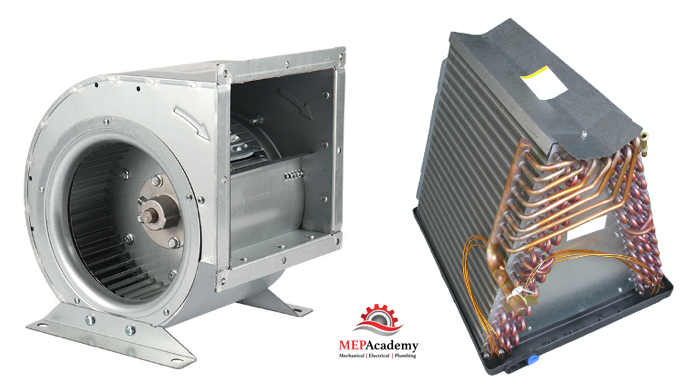
The evaporator will also remove moisture from the air in addition to cooling the air. The change in temperature is considered sensible cooling, while the removal of moisture is considered latent cooling. Like that glass of ice water sitting outside, the air surrounding the glass meets the cold glass surface and the moisture in the air condenses out onto the glass. A similar event occurs on the cooling coil, as the warm air drops in temperature when it meets the cold coil some of the moisture or water vapor will condense on the cooling coil and become condensate. The condensate will drip off the coil into a drain pan where it is connected by a pipe leading to the sewer, drywell, or the tailpiece of a sink.
Condenser Heat Exchanger and Fan
The condenser heat exchanger is located outside, where the refrigerant will reject the heat to the outdoor air. The outdoor condenser section is where the compressor, heat exchanger and condenser fan are located, this is considered the high-side of the system.
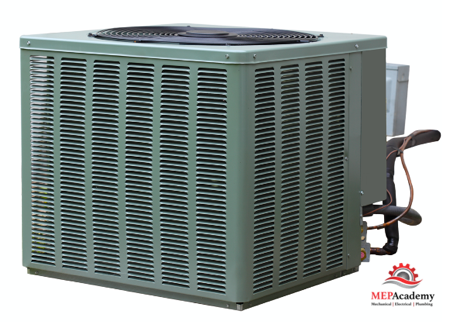
This is called an air-cooled condenser because the fan blows air over the coil that facilitates the heat transfer , as opposed to a water-cooled condenser. Remember that heat moves from the warmer to the cooler medium. Even though the outdoor air is warm, the refrigerant is warmer, allowing heat to transfer from the condenser to the outdoor air. Remember the compressor raised the pressure and temperature of the refrigerant.
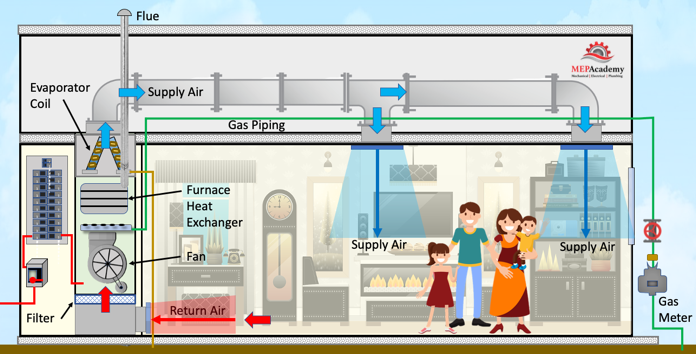
The problem comes about when it is exceptionally hot outside, then the temperature of the outdoor air and the refrigerant are getting closer to each other and the transfer of heat is slowed down, causing a loss of cooling capacity. Most condenser are rated for an outside design temperature of 95F. When the temperature outdoors exceeds this amount the system becomes derated, meaning that less cooling capacity is available. The refrigerant leaving the condenser passes through the expansion valve.
Checkout these Air Conditioners hereExpansion Valve
The expansion valve controls the volume of refrigerant that passes from the outdoor condenser coil to the indoor evaporator coil.
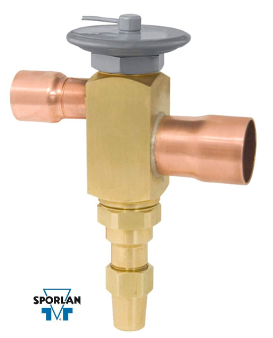
The compressor increased the pressure of the refrigerant and now the expansion valve lowers the pressure as the refrigerant is metered through the valve from the high-side to the low-side. This is how the cooling capacity is controlled, the more refrigerant that is let through, the more heat that can be absorbed from the space.
Thermostat
The thermostat is the main controller that you use to call for cooling or heating, and where you set your requirements for space temperature.
Cooling Capacity
The air conditioners cooling capacity is rated in tons. Tons is not an indication of its weight, but of the air conditioners cooling capacity. One ton is equal to 12,000 Btuh, which is an expression of the ability of the air conditioner to remove heat. The higher the number, the more heat that can be removed from a building.
When shopping or being quoted an air conditioner, the contractor may quote the tonnage of the unit to be installed, or the btu’s per hour. Either way you can determine the value of the other as (1-Ton = 12,000 BTUH). The thermostat maybe set low to provide more cooling, but the system will be at maximum capacity if it’s on an exceptionally hot day. The capacity of the air conditioner is determined by doing a load calculation. For additional information see our video “What is a Ton of Air Conditioning”.
Load Calculation
Contractors and engineers have available to them the ability to size air conditioners using Load Calculation software. To get an accurate determination of the cooling load, which is required to size the air conditioner correctly, load calculation software should be used. The load calculation program will take into consideration the buildings orientation to the sun for a proper solar load. The determination of the composition of the walls, glass, doors, and roof are important as their “R” values determine the rate at which heat is transferred through them. The square footage of the home or building will also be considered. All of this is easily done with a load calculation program.
Air conditioners should never be sized using rule of thumb values, as there is a tendency to oversize the unit which causes more problems. A few of the problems of oversizing is the additional initial cost of the equipment and installation, and the possible poor performance of moisture removal. When air conditioners are oversized the air conditioner cools faster than normal, which causes it to frequently turn on and off. When an air conditioner cycles on and off frequently it doesn’t allow enough time for moisture removal. This could mean a cool, but damp space. Oversizing also leads to increased energy bills, additional maintenance cost and early equipment replacement cost due to an increase in the on and off cycling times. Oversized air conditioners won’t run efficiently, and energy efficiency is critical for a cost effective system.
Energy Efficiency of Air Conditioners
Air conditioners are given a grade for how efficient they convert electrical energy into useful cooling capacity. This is like a grade you might get in school, the better the grade, the smarter you are deemed to be about the subject. Air conditioners are rated by their Seasonal Energy Efficiency Ratio (SEER) value. The higher the number the better the air conditioner is at using the electrical energy consumed.
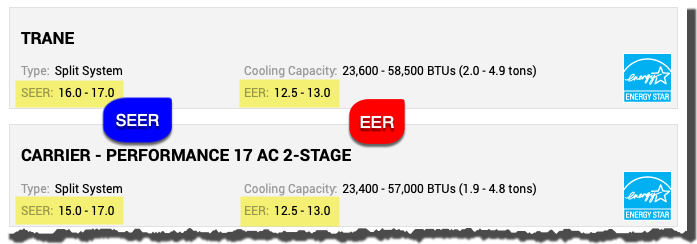
If you live in a hot and dry climate where the peak load is critical, then you will want to look at the Energy Efficiency Ratio (EER) of the air conditioner. The EER rates the unit based on the peak load conditions, which is more likely to occur in hot climates.






